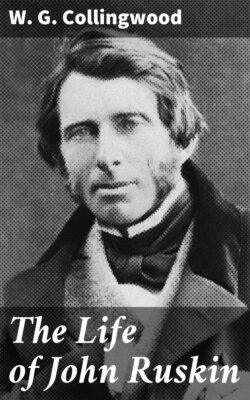Читать книгу The Life of John Ruskin - W. G. Collingwood - Страница 14
На сайте Литреса книга снята с продажи.
MOUNTAIN-WORSHIP (1830–1835)
ОглавлениеTable of Contents
Critics who are least disposed to give Ruskin credit for his artistic doctrines or economical theories unite in allowing that he taught his generation to look at Nature, and especially at the sublime in Nature—at storms and sunrises, and the forests and snows of the Alps. This mission of mountain-worship was the outcome of a passion beside which the other interests and occupations of his youth were only toys. He could take up his mineralogy and his moralizing and lay them down, but the love of mountain scenery was something beyond his control. We have seen him leave his heart in the Highlands at three years old; we have now to follow his passionate pilgrimages to Skiddaw and Snowdon, to the Jungfrau and Mont Blanc.
They had planned a great tour through the Lakes and the North two years before, but were stopped at Plymouth by the news of Mrs. Richardson's death. At last the plan was carried out. A prose diary was written alternately by John and Mary, one carrying it on when the other tired, with rather curious effect of unequally-yoked collaboration. We read how they "set off from London at seven o'clock on Tuesday morning, the 18th May," and thenceforward we are spared no detail: the furniture of the inns; the bills of fare; when they got out of the carriage and walked; how they lost their luggage; what they thought of colleges and chapels, music and May races at Oxford, of Shakespeare's tomb, and the pin-factory at Birmingham; we have a complete guide-book to Blenheim and Warwick Castle, to Haddon and Chatsworth, and the full itinerary of Derbyshire. "Matlock Bath," we read, "is a most delightful place"; but after an enthusiastic description of High Tor, John reacts into bathos with a minute description of wetting their shoes in a puddle. The cavern with a Bengal light was fairyland to him, and among the minerals he was quite at home.
Then they hurried north to Windermere. Once at Lowwood, the excitement thickens, with storms and rainbows, mountains and waterfalls, boats on the lake and coaching on the steep roads. This journey through Lakeland is described in the galloping anapæsts of the "Iteriad," which was simply the prose journal versified on his return, one of the few enterprises of the sort which were really completed.
To readers who know the country it is interesting as giving a detailed account in the days when this "nook of English ground" was "secure from rash assault." One learns that, even then, there were jarring sights at Bowness Bay and along Derwentwater shore, elements unkind and bills exorbitant. Coniston especially was dreary with rain, and its inn—the old Waterhead, now destroyed—extravagantly dear; "but," says John, with his eye for mineral specimens, "it contains several rich coppermines." An interesting touch is the hero-worship with which they went reverently to peep at Southey and Wordsworth in church; too humble to dream of an introduction, and too polite to besiege the poets in their homes, but independent enough to form their own opinions on the personality of the heroes. They did not like the look of Wordsworth at all; Southey they adored. The dominant note of the tour is, however, an ecstatic delight in the mountain scenery; on Skiddaw and Helvellyn all the gamut of admiration is lavished.
On returning home, John began Greek under Dr. Andrews, and was soon versifying Anacreontics in his notebooks. He began to read Byron for himself, with what result we shall see before long; but the most important new departure was the attempt to copy Cruikshank's etchings to Grimm's fairy tales, his real beginning at art. From this practice he learnt the value of the pure, clean line that expresses form. It is a good instance of the authority of these early years over Ruskin's whole life and teaching that in his "Elements of Drawing" he advised young artists to begin with Cruikshank, as he began, and that he wrote appreciatively both of the stories and the etchings so many decades afterwards in the preface to a reprint by J.C. Hotten.
His cousin-sister Mary had been sent to a day-school when Mrs. Ruskin's lessons were superseded by Dr. Andrews, and she had learnt enough drawing to attempt a view of the hotel at Matlock, a thing which John could not do. So, now that he too showed some power of neat draughtsmanship, it was felt that he ought to have her advantages. They got Mr. Runciman the drawing-master, chosen, it may be, as a relative of the well-known Edinburgh artist of the same name, to give him lessons, in the early part of 1831. His teaching was of the kind which preceded the Hardingesque: it aimed at a bold use of the soft pencil, with a certain roundness of composition and richness of texture, a conventional "right way" of drawing anything. This was hardly what John wanted; but, not to be beaten, he facsimiled the master's freehand in a sort of engraver's stipple, which his habitual neatness helped him to do in perfection. Runciman soon put a stop to that, and took pains with a pupil who took such pains with himself—taught him, at any rate, the principles of perspective, and remained his only drawing-master for several years.
A sample of John Ruskin's early lessons in drawing, described by him in letters to his father, may be not without interest. On February 20, 1832, he writes:
